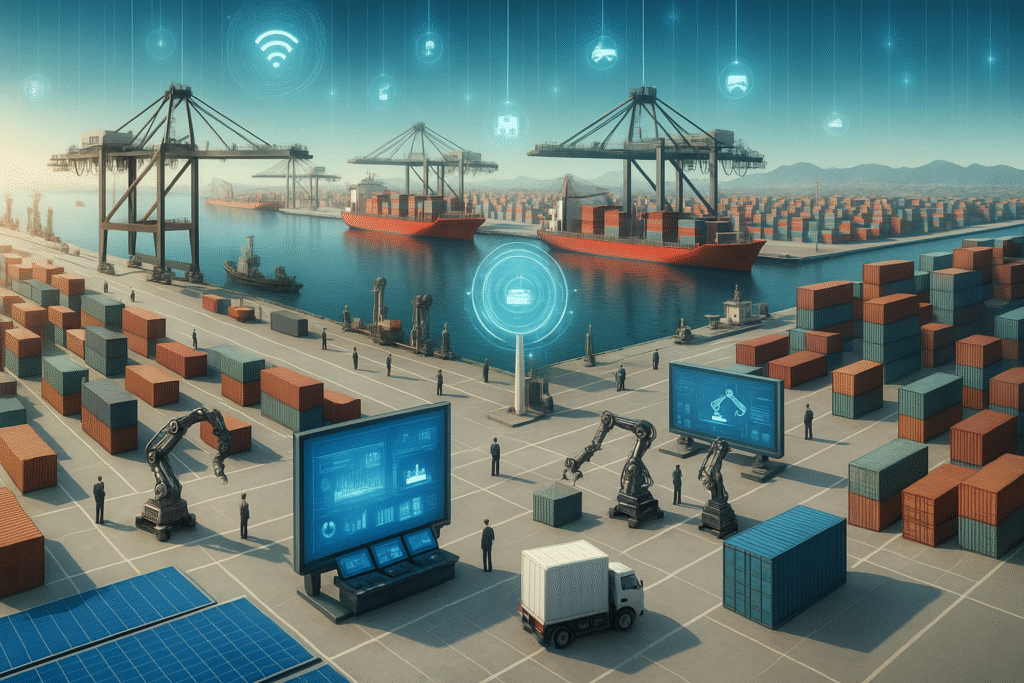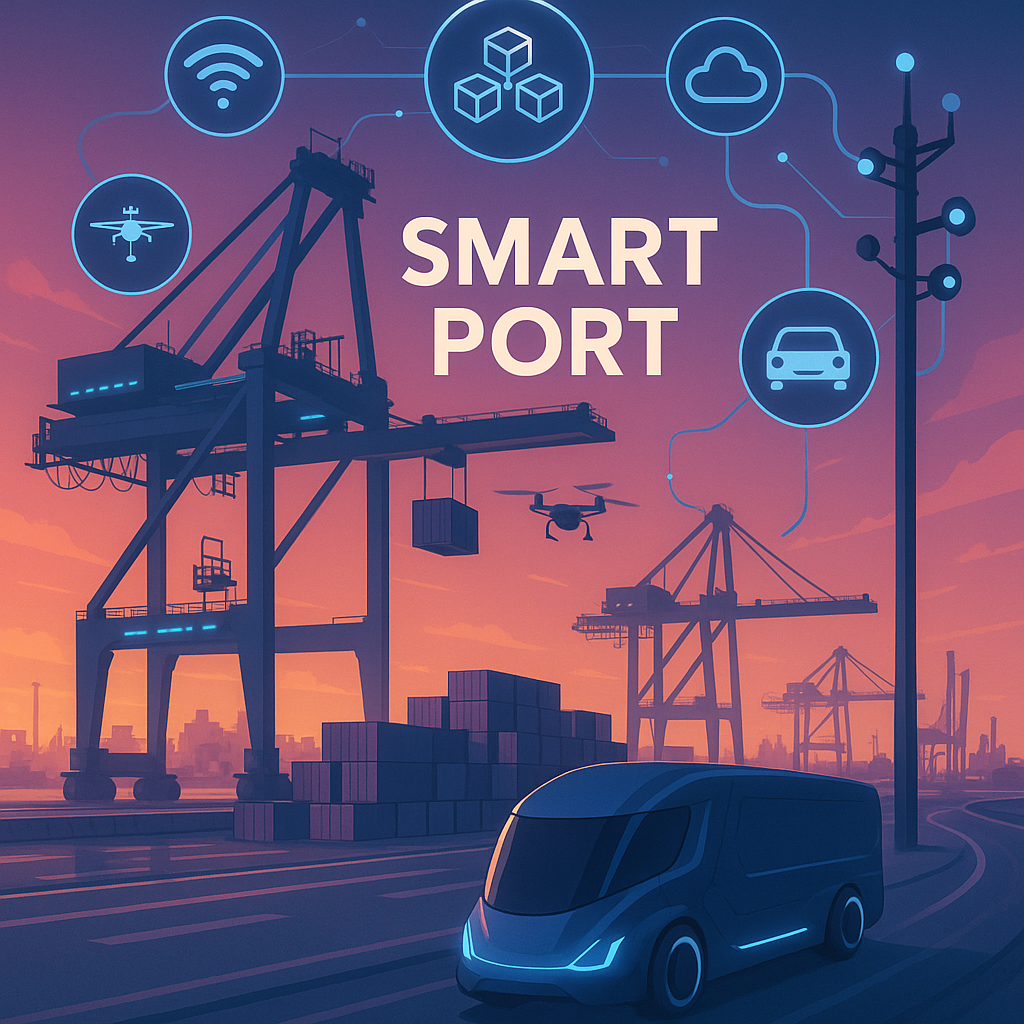Port Automation and Smart Ports: Shaping the Future of Global Shipping

Port Automation and Smart Ports: Shaping the Future of Global Shipping
The global shipping industry is embracing a digital transformation that includes smart ports and port automation as essential innovations. As international trade grows, ports are pressured to become more efficient and sustainable. By incorporating advanced technologies like artificial intelligence (AI), robotics, and the Internet of Things (IoT), smart ports are revolutionizing cargo handling, port management, and environmental impact. This shift not only streamlines port operations but also reduces congestion, cuts emissions, and improves the sustainability of the global logistics chain.
Introduction
As global trade volumes rise, ports are under increasing pressure to operate more efficiently and sustainably. In response, many ports are evolving into smart ports—hubs equipped with advanced technologies such as AI, robotics, and IoT. This transformation not only improves the speed and safety of cargo handling but also reduces the environmental footprint of port operations. By optimizing the flow of goods and streamlining operations, smart ports pave the way for a more sustainable global logistics chain.
The Rising Demand for Efficient Port Operations
Ports are critical nodes in the global supply chain, handling vast amounts of cargo daily. With growing trade volumes and the demand for faster turnarounds, traditional port operations are struggling to keep pace. Ports now face increased challenges, from long waiting times and bottlenecks to high emissions and complex logistics. The need for improved efficiency and environmental sustainability has led to the adoption of smart technology and automation to meet these demands and ensure that ports can handle current and future trade volumes.
Understanding Smart Ports and Port Automation
A smart port leverages technology to automate and optimize various port functions, including cargo handling, vessel scheduling, and equipment monitoring. These ports differ from traditional ports in that they rely heavily on digital tools and automation to reduce human error, lower costs, and improve the speed of operations. By integrating automation, smart ports enhance both the efficiency and safety of cargo management while reducing the environmental impact through sustainable practices.
Key Technologies Driving Port Automation
The transformation of ports into smart hubs is powered by several key technologies:
- Automated Cranes and Robots: These machines load and unload cargo with high precision, reducing the time and labor involved in cargo transfer.
- AI Algorithms for Vessel Scheduling and Berth Management: AI streamlines port logistics by optimizing vessel schedules and berth assignments, helping to prevent delays and manage resources more effectively.
- IoT Sensors for Tracking and Monitoring: IoT devices track the location and status of containers, equipment, and infrastructure in real time, enabling better visibility and control over port activities.
By integrating these technologies, smart ports are able to operate in a way that minimizes congestion, improves cargo flow, and enhances the safety and productivity of port workers.

Automated Cranes and Robots in Ports
Automation has revolutionized cargo handling through the use of automated cranes and robots. Unlike traditional cranes, automated cranes can operate continuously, reducing loading and unloading times and minimizing the need for human intervention. Robots, equipped with sensors and cameras, can move autonomously within port terminals to handle containers, avoiding human error and enhancing efficiency.
This level of automation ensures that cargo is handled with greater precision, reducing the chances of delays and damaged goods. By decreasing reliance on human labor for repetitive tasks, ports can also improve safety and reduce overall operational costs. Automated systems, in many cases, use electric power rather than diesel, lowering emissions and energy consumption.
AI Algorithms for Optimizing Port Operations
AI algorithms play a crucial role in managing the logistical complexity of modern ports. With hundreds of vessels arriving and departing each day, efficient scheduling is essential to minimize waiting times and prevent congestion. AI can analyze data from past schedules, weather conditions, and real-time ship movements to create optimized schedules for incoming and outgoing vessels.
By automating these processes, ports reduce idle times for ships, which in turn decreases fuel consumption and emissions. AI also helps ports make data-driven decisions, enabling efficient resource allocation and proactive solutions to potential issues, like delayed arrivals due to adverse weather conditions. The result is a faster, more responsive, and less congested port environment.
IoT Sensors for Real-Time Tracking and Monitoring
The Internet of Things (IoT) is integral to the success of smart ports, as it enables real-time tracking and monitoring of cargo, equipment, and infrastructure. IoT sensors embedded in containers, cranes, and trucks provide detailed information on location, condition, and performance. This data allows operators to monitor every aspect of port operations, ensuring that cargo flows efficiently through the facility.
By tracking equipment conditions, IoT also enables predictive maintenance of port machinery, helping prevent costly breakdowns and minimizing downtime. Additionally, IoT enhances operational transparency by providing real-time data that stakeholders, from shippers to port managers, can access to make more informed decisions.
Data Analytics and Predictive Maintenance
Data analytics is transforming port operations by enabling predictive maintenance strategies. Predictive maintenance uses historical and real-time data from IoT sensors to predict when equipment will require servicing, which reduces unexpected breakdowns and enhances operational reliability.
This approach lowers maintenance costs and extends the lifespan of port equipment. Data analytics also allows ports to analyze performance metrics over time, enabling operators to make strategic decisions that improve overall productivity.
Impact of Smart Ports on Sustainability
Smart ports contribute to environmental sustainability by improving efficiency, which in turn reduces emissions and lowers energy consumption. Ports that implement automation can reduce vessel idle times by optimizing scheduling and berth management, which minimizes fuel use and emissions from ships waiting in port. Additionally, automated cargo handling systems are generally more energy-efficient than manual systems, reducing the port’s carbon footprint.
IoT-based energy management systems further contribute to sustainability. By tracking and controlling power usage, these systems help ports optimize their energy consumption and identify areas where energy efficiency can be improved. In many cases, smart ports are also incorporating renewable energy sources like solar panels, further enhancing their environmental performance.
Environmental Benefits of Automated Cargo Handling
Automated systems operate with high efficiency, consuming less energy than traditional manual systems. Automated cranes, for instance, handle cargo with greater precision and require less time to complete each operation, which results in energy savings. This efficiency directly translates into reduced carbon emissions, helping ports meet environmental targets.
As ports move toward sustainable operations, many are considering renewable energy sources to power their facilities. By embracing energy-efficient automation and renewable power, ports not only lower their emissions but also position themselves as leaders in the sustainable shipping industry.
Renewable Energy Integration in Smart Ports
Smart ports are increasingly integrating renewable energy sources such as solar and wind power into their operations. Solar panels installed on port buildings and equipment help offset energy usage, further reducing emissions. Additionally, renewable energy sources can power electric cranes and other automated equipment, supporting cleaner port activities.
The use of renewables reduces dependency on fossil fuels and aligns with global climate goals, making renewable energy integration a significant part of the future of smart ports.
Global Examples of Smart Ports
Ports in Rotterdam, Hamburg, and Singapore are leading the way in adopting smart port technologies:
- Port of Rotterdam: Known for its innovation, Rotterdam has implemented AI and IoT systems to monitor cargo flow and optimize energy use, significantly reducing port congestion.
- Port of Hamburg: Hamburg has integrated IoT and data analytics for real-time tracking and predictive maintenance, improving operational efficiency and sustainability.
- Port of Singapore: As one of the busiest ports globally, Singapore uses automation and AI to enhance its cargo handling and reduce waiting times, setting new benchmarks for operational efficiency.
These examples showcase how smart ports are transforming port operations, serving as models for future developments.
Challenges in Implementing Smart Port Technology
The shift to smart ports is not without challenges. Implementing these advanced technologies requires substantial financial investment, which can be a barrier for smaller ports. Additionally, smart ports face cybersecurity concerns, as interconnected digital systems increase the risk of cyberattacks. Ensuring data protection and system security is critical to maintaining smooth operations and safeguarding sensitive information.
Despite these challenges, the benefits of smart ports in terms of efficiency, cost savings, and sustainability are encouraging more ports to embrace automation.
Conclusion
Port automation and smart ports are reshaping the future of global shipping, offering a transformative solution to meet the growing demands of international trade while minimizing environmental impact. By utilizing AI, IoT, and robotics, smart ports improve operational efficiency, reduce congestion, and enhance sustainability. As more ports adopt these technologies, the shipping industry will be better equipped to handle future trade volumes and contribute to a cleaner, greener global logistics chain.




